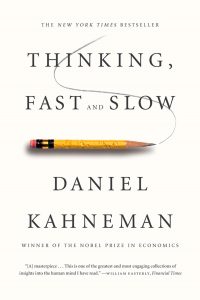
In his spectacular book, Kahneman identifies the 2 systems in your mind in this manner:
“System 1 operates automatically and quickly, with little or no effort and no sense of voluntary control.
System 2 allocates attention to the effortful mental activities that demand it, including complex computations. The operations of System 2 are often associated with the subjective experience of agency, choice, and concentration.”
For several years these 2 systems have existed in our brain to help us navigate and interact in life. System 1 is an instinctive system that cannot be switched off. It helps us to perform cognitive tasks in our everyday life like identifying threats, facial recognition etc. System 2 enables us to solve complex problems. Though useful, it demands effort and energy to engage it. This is why many times, our brain tends to avoid system 2 which results in rash and irrational decisions.
# Key Takeaways:
– The human mind operates in two systems: System 1, which is fast, intuitive, and automatic, and System 2, which is slow, deliberate, and effortful.
– System 1 thinking is prone to biases and errors, while System 2 thinking is more rational and logical.
– Our decisions are often influenced by heuristics, or mental shortcuts, that can lead to errors in judgment.
– The availability heuristic, where we judge the likelihood of an event based on how easily we can recall similar events, can lead to overestimating rare events and underestimating common ones.
– The anchoring effect, where our judgments are influenced by the first piece of information we receive, can lead to biased decision-making.
– The book also discusses the impact of emotions on decision-making, and how they can override rational thinking.
– The concept of loss aversion, where we tend to value losses more than gains, can also affect our decision-making.
– The book also delves into the concept of prospect theory, which explains how people make decisions under risk and uncertainty.
# Practical Applications:
– Understanding the two systems of thinking can help individuals become more aware of their thought processes and make more deliberate decisions.
– By recognizing and being aware of biases and heuristics, individuals can make more rational and logical decisions.
– In real-world scenarios, leaders and managers can use the concepts in the book to improve decision-making processes within their organizations.
– The book also offers strategies for overcoming biases and improving decision-making, such as slowing down and using deliberate thinking when making important decisions.
# Valuable Insights for Leaders and Managers:
– Chapter 13, “The Engine of Capitalism,” offers valuable insights for leaders and managers in understanding the role of intuition and rational thinking in business decisions.
– Chapter 17, “Regression to the Mean,” discusses the concept of luck and how it can influence our perceptions and decisions, which can be valuable for leaders and managers in evaluating performance and making decisions based on data.
– Chapter 21, “Intuitions vs. Formulas,” explores the benefits and limitations of using intuition and formulas in decision-making, which can be useful for leaders and managers in understanding when to rely on each approach.
# Case Studies and Examples:
– The book includes several case studies and examples to illustrate its principles, such as the story of the Israeli Air Force and their use of intuition in decision-making.
– The concept of loss aversion is illustrated through the example of a bet on a coin toss, where individuals are more likely to reject a bet that offers a 50/50 chance of winning or losing.
– The anchoring effect is demonstrated through an experiment where participants were asked to estimate the percentage of African countries in the United Nations, and their estimates were influenced by a random number given to them beforehand.
Leave a Reply